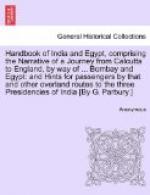So the revel progresses, sometimes dying down into a slow movement in which only the hoarse breathing of the men, the tap-tap of female heels, is heard; and anon breaking into a kind of gallop, punctuated with shouts of “Bravo” “Hip, hip, Hurrah” and the queer dental shriek, which our friendly serang tells us is the peculiar note of the African reveller. But at length Nature asserts her sway; and after the dancing has lasted almost without interruption for three hours, the Sidi Patel, Hassan, gives permission for a brief recess, during which he introduces to the spectators the son of the Sidi chief Makanda,—a fine specimen of manhood whose six-foot stature belies the fact that he is still according to Sidi views a minor incapable of looking after his own interests. At this juncture too an itinerant coffee-seller limps into the room with his tin can and cups and is straightway pounced upon by the breathless performers, who apparently find coffee better dancing-powder than any other beverage.
“How much” you ask him “do you charge per cup?”
“Saheb,” comes the answer, “for two rupees you can treat the whole gathering, men, women and children to a cup apiece; for this coffee is of the best!” So we pay our footing in kind and bid adieu to the dancers who are prepared to continue the revels till the early hours of the morning. As we turn the corner into Ripon Road, we catch a final glimpse of our bemedalled serang executing a fandango on the door-step, and of the Sidi Patel with a cup of hot coffee in his hand shouting in broken English, “Good-night, God Save the King!”
XIV.
A KONKAN LEGEND.
Legend and tradition have rendered many a spot in India sacrosanct for all time; and to no tract perhaps have such traditions clung with greater tenacity than to the western littoral which in the dawn of the centuries watched the traders of the ancient world sail down from the horizon to barter in its ports. As with Gujarat and the Coast of Kathiawar, so with the Konkan it is a broken tale of strange arrivals, strange building, strange trafficking in human and inanimate freight that greets the student of ancient history and bewilders the ethnologist. The Konkan, in which in earliest days “the beasts with man divided empire claimed,” and which itself is dowered with a legendary origin




